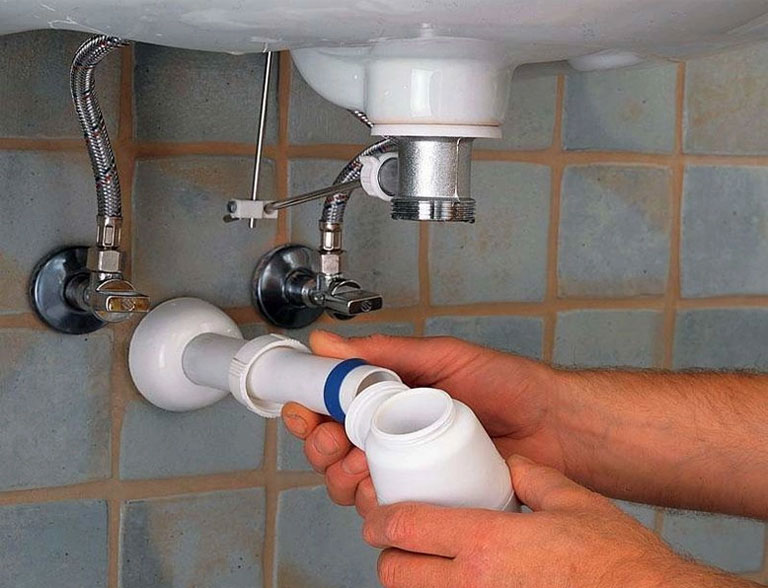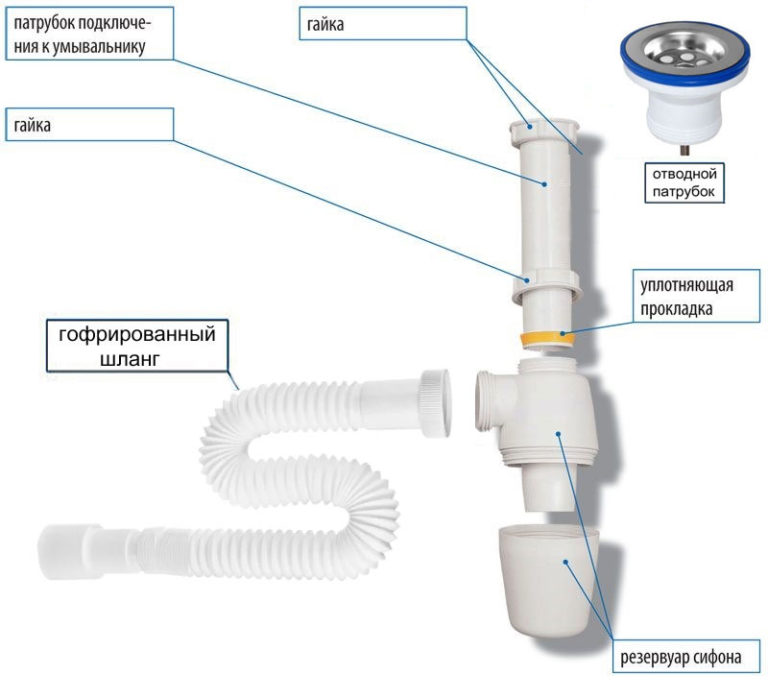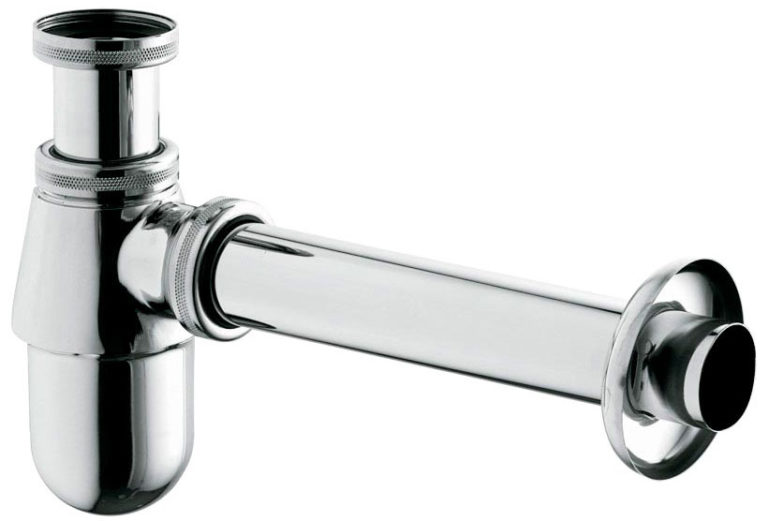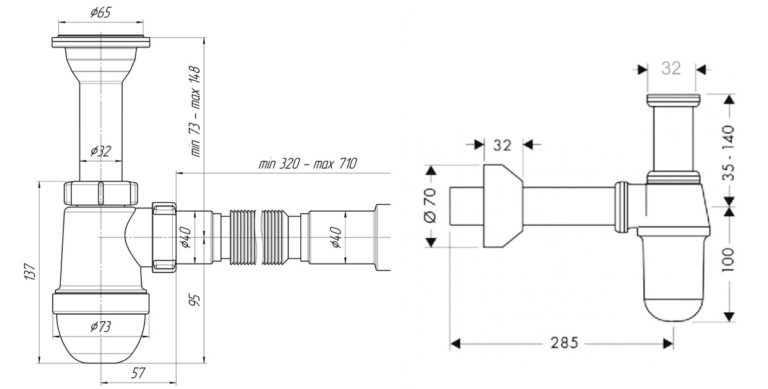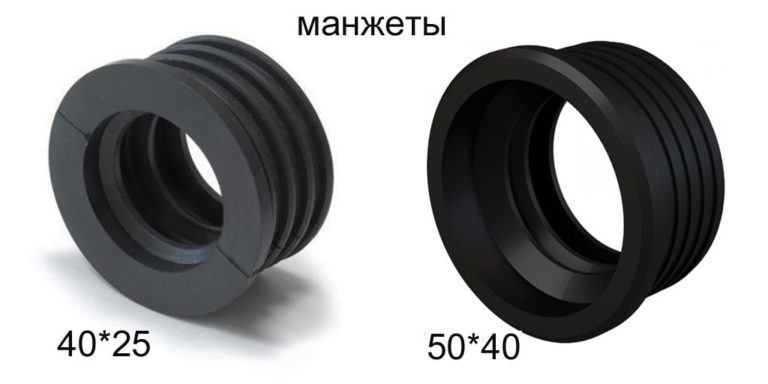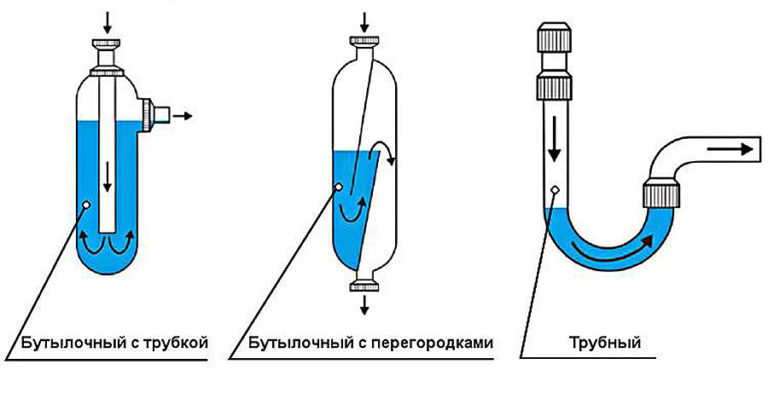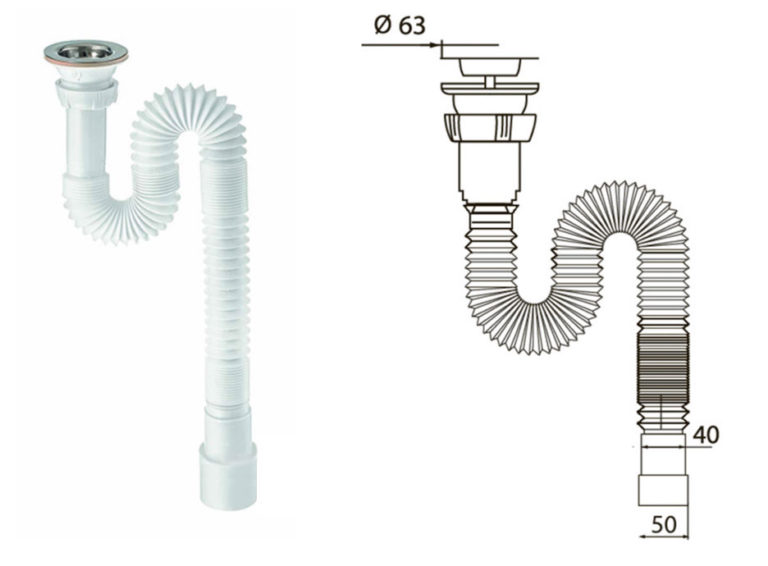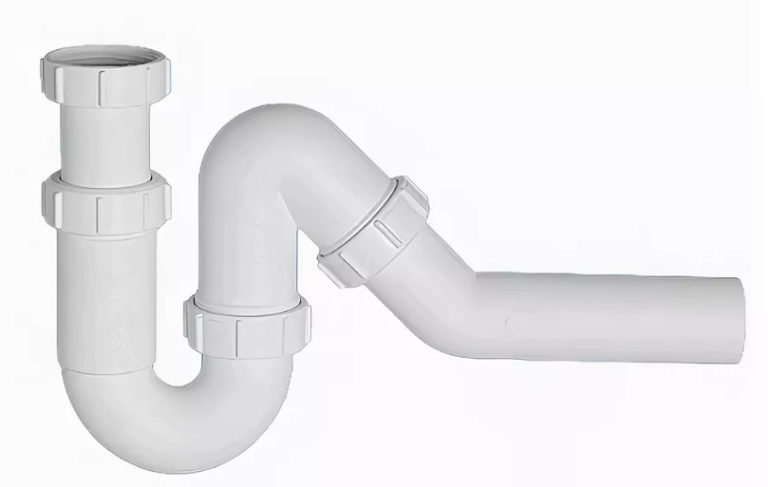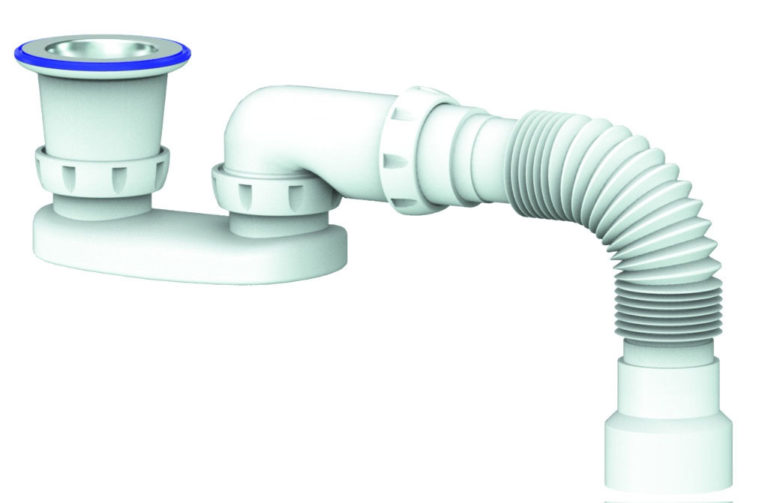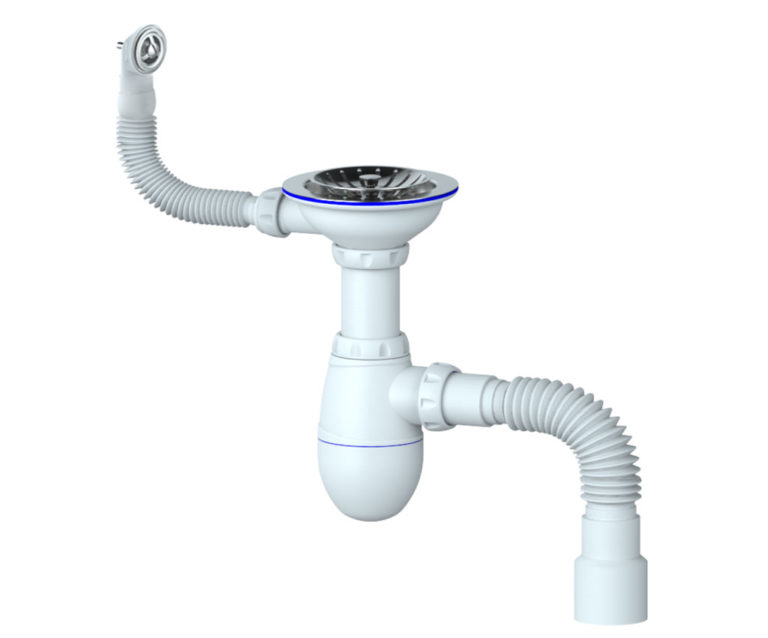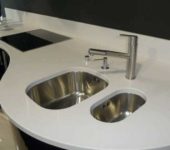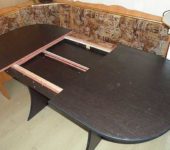Selection and installation of a siphon for a sink (sink) in the kitchen
Trying to equip kitchens with fashionable headsets and modern household appliances, you should not neglect a small device installed under the sink called a siphon. The sink siphon will avoid some unpleasant moments when using the drainage system. So, what this device is and how it works, we will consider in the article.
A siphon is a pipe system that creates a water lock between the sink and the sewer. This design allows you to avoid the ingress of unpleasant odors from the sewer network into the room, and also collects debris from the sink in the sump, which prevents clogging of the drain system.
The role of a siphon can be played by a pipe bent in a special way, which also creates a water lock. On sale, a siphon may come with a sink, but more often it has to be purchased separately.
The content of the article
Why do you need a siphon
The kitchen sink (sink) is connected to the central or local sewerage system. Some homeowners and apartment owners connect the drain directly to a sewage piping system. For this, a corrugated pipe is usually used, which easily bends in the desired direction. However, if you do not create a water seal, the "aroma" from the sewer system will enter the kitchen. The main purpose of the siphon is to block unpleasant odors from the sewer.
Manufacturers produce quality products that differ:
- reliability;
- strength;
- durability exceeding the service life of the mixer;
- resistance to chemical compounds, high temperatures and mechanical stress;
- simple installation, which allows a person without experience to install a siphon in the kitchen;
- versatility of use.
How does he work
The principle of operation of the siphon is based on its design features. At the bottom of the device, called a reservoir or sump, there is always water coming from the sink bowl. At this moment, high pressure arises in the drain - this leads to the displacement of the "old" fluid.
When the water supply stops, the pressure in the siphon is equalized. As a result, some of the liquid remains in the curved part. This water plug prevents unpleasant odors from entering the room.
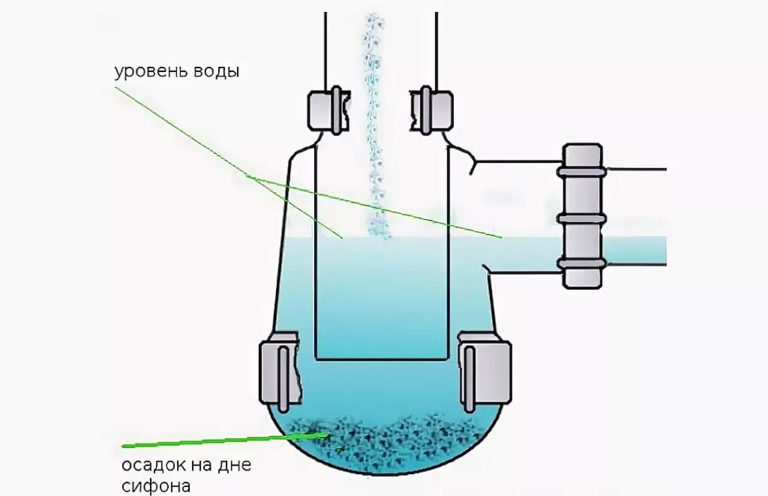
Water flows freely from the siphon and enters the sewerage system, and air cannot get from the sewerage system into the room, since the vertical pipe is below the water level
The siphon plays another important role. Since it is installed after the kitchen sink, it is able to retain some debris. It accumulates in the sump and is easily removed by partial disassembly when the tank is removed - the owner of the home can carry out this procedure on his own, without the involvement of a professional plumber. Preventing direct waste from entering the sewer system will prevent clogging.
General device device
Different manufacturers produce sewer siphons, structurally they differ little from each other. The main details of the so-called elbow for the kitchen sink include:
- Decorative grill with small holes in the drain to prevent large waste from entering the sewer system.For its installation, the kit includes a rubber gasket for the tightness of the joint between the grill and the sink.
- Branch pipe for connecting the outlet and the filter grid. The part is fastened with a corrosion-resistant metal bolt and nut.
- Siphon with removable bottom reservoir for cleaning in case of clogging - it allows you to completely disassemble the elbow device.
The design of modern siphons (not only for the sink in the kitchen, but also for the washbasin in the bathroom with or without overflow) necessarily contains fixing rings with gaskets for connecting individual parts of the devices. The kit also includes a corrugated tube for connecting the outlet of the siphon reservoir and the sewer inlet.
Manufacturers create and produce different models, therefore their designs differ somewhat in the device and in a different number of parts.
Manufacturing material
Manufacturers produce plastic or metal plums. The metal used for making is usually brass, bronze, or stainless steel. Products in this design are perfect for an open location, as they will become one of the elements of the kitchen decor. However, they are significantly more expensive than plastic structures.
A common disadvantage is the accumulation of dirt on the inner surface of the water seal. This leads to a gradual decrease in the section of the device. If maintenance is not performed regularly, clogging will occur. However, dirt and grease adhere less to plastic than to metal.
Modern metal drain structures are purchased if a set of expensive plumbing fixtures is installed and an exclusive interior is created. The installation of a metal siphon under the sink is often performed by professionals, because the joints between its individual parts are sealed using rubber seals and fum tape.
Cast-iron siphons can be seen in old houses - these are real rarities and are no longer produced.
It is not a problem to put a siphon on the sink in the kitchen when the diameter of the drain and the sewer pipe are the same size. However, when there are differences in pipe diameters, it is necessary to think in advance about their connection. In this case, various cuffs and their mating pipes are used. For example, an internal double-socket tee of 50 mm will allow you to connect a 50 * 40 sink and a 50 * 25 washing machine with sealing cuffs.
Common types
Manufacturers produce several types of sink siphons. They are selected depending on the characteristics of the installation site.
Corrugated drain
The corrugated tube is convenient to use when the sink outlet has a non-standard location. This device is also used if it is planned to install additional equipment or any necessary items under the sink. When connecting it to the sink, you need to pay attention to the amount of water in the curved place. It should be enough to create a reliable water lock, which guarantees reliable protection against the penetration of odors from the sewer.
Drainage in the form of a corrugated tube is not an ideal design, because dirt quickly accumulates on the edges of the product.
Structurally, the corrugated siphon consists of the following elements:
- branch pipe with grid and union nut;
- corrugated tube.
Additionally, a pipe mount may be required.
Corrugated drain is installed in minutes.First, we fix the drain pipe with a grid on the sink. Fixation is done using the supplied gasket and screw. Then the corrugation is inserted into the pipe with one end and fixed with a nut, and the other side is inserted into the sewer pipe. If cleaning is necessary, the corrugated hose is disconnected from the branch pipe and the drain. Then it is washed or changed to a new one.
Bottle drain
Bottle siphons are most often installed. They are well suited for draining dirty water and other impurities from multiple sinks. In this case, the installation of the required number of special bends is carried out.
The design of the bottle drain consists of the following elements:
- a grill made of metal or plastic;
- inlet pipe;
- capacity bottle;
- a branch pipe for draining sewage into the sewer;
- adapter piece that allows you to connect the siphon to the sewer system.
The bottle drain is a completely tough product. If necessary, the design is supplemented with a corrugation for more convenient connection to the sewer. Bottle drain cleaning is performed by unscrewing the lower part of the container in the form of a bottle and removing accumulated dirt.
Pipe drain
This type of siphon is installed not only on sinks, but also on bathrooms. It has a completely rigid construction - it looks like the letters S and U.
Since many modern kitchens are equipped with dishwashers, the pipe siphon can be equipped with an additional outlet.
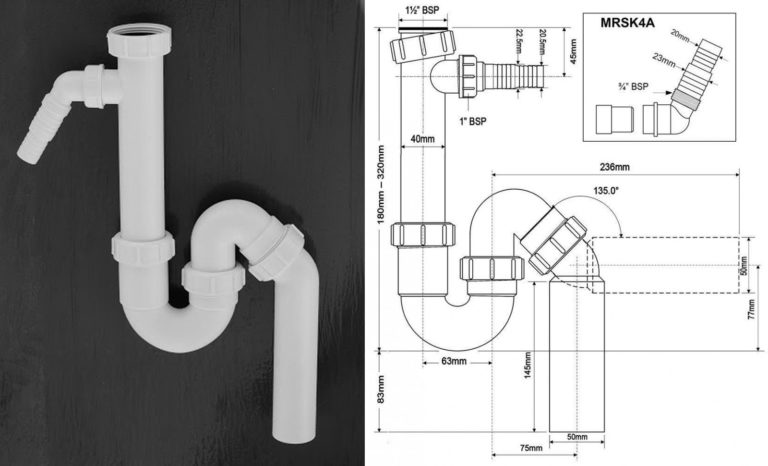
Siphon for McAlpine (Great Britain) sinks with outlet for household appliances, 40 mm (MRSK6). Model MRSK4A is equipped with a corner bend. When choosing, be guided by the specified dimensions
There are models of tubular siphons with jet stream separation. Such siphons are not attached to the sink - after installation, there is a difference between the siphon and the sink. It is necessary so that microbes from the sewer cannot get into the sink. They are used in preschool institutions and food service outlets.
Flat drain
This is a small siphon under the sink where size is critical. Usually used when a "washing machine" is installed under the sink or dishwasher. There are models with jet stream break.
In addition to its small dimensions, a distinctive feature of a flat drain is also a rigid structure. These siphons are rarely clogged. If it becomes necessary to perform a complete cleaning, the grate is unscrewed, and then the entire structure is removed from the sink.
With overflow
When the sink has overflow protection, a siphon with an overflow is installed under it. The design of the product contains an additional branch pipe to which a small diameter tube is connected from the overflow hole in the upper part of the sink. This design does not allow the sink to overflow with water and reduces the risk of flooding the premises and neighbors living on the floor below.
There are also plums with one or two outlets at the neck. They are used when additional connection of a dishwasher or washing machine is required.
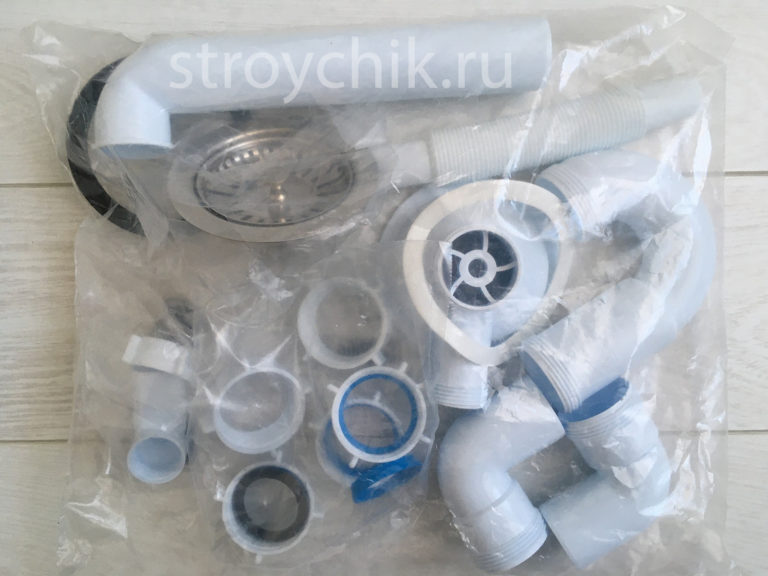
Notice how many accessories the pipe siphon with overflow has. If you are afraid to get confused during self-installation, it is better to invite a professional plumber
Basic selection rules
To ensure effective drainage of used water in the kitchen, you need to choose the right siphon. To do this, you must take into account the following recommendations:
- You need to purchase a kit immediately. In addition to the siphon, it must contain all the necessary components for connecting it to the sewer. If the parts are bought separately, there is a possibility that they will not be able to assemble a single structure.
- It is necessary to measure the free space under the sink in advance.If it is minimal, a short siphon should be preferred.
- With a closed installation, there is no need to purchase an expensive designer siphon. It is better to buy a less beautiful product of good quality, but at a lower price. After all, no one will see it, and it will not spoil the interior of the kitchen.
- When the sink siphon is open, it makes sense to buy a product in a decorative design.
There is always an instruction in the kit of each device - it must be carefully studied before installation. It is also necessary to pay attention to the absence of damage to the siphon, the quality of the thread, sealing elements and plugs.
Installation nuances
To install a siphon on a sink, an experienced person needs to spend a few minutes. If you don't succeed so quickly, it's okay. First you need to prepare the tool and supplies. The maximum that you may need:
- screwdriver;
- gas wrench;
- sealant.
As a rule, when installing plastic products, only a flat-head screwdriver is sufficient.
If it is necessary to change the siphon, the old product is dismantled first. This procedure begins by placing a basin or other container under the drain to prevent water from spilling onto the floor. First, all parts of the plastic siphon are removed. Then the protective grid is removed by unscrewing the screw. If a metal drain is dismantled, you will have to use a gas wrench.
Finally, the inside of the drain hole in the sewer pipe is cleaned of dirt. You can use a rag or paper towel to do this.
How to properly collect the drain
At the beginning of the process, you need to check the presence of all parts. To do this, we study the attached instructions, and lay out all the elements, for example, on the table.
Installation of a bottle drain is often carried out. Its assembly is carried out in the following sequence:
- Separate parts of the flask are connected after installing a gasket of small thickness. The sealing element must be well pressed against the part from all sides.
- The nut is fixed on the corrugation.
- A cone-shaped gasket is put on the corrugated pipe. The sharp part of the sealing element is closer to the edge.
- The corrugated tube is inserted into the outlet of the flask and fixed by tightening the nut.
- On the other part with the grid, a second nut and a gasket are fixed.
- The connection of two separate parts of the siphon is made by tightening the nut.
At the end of the process, the drain is fixed under the sink. If necessary, you can use a silicone sealant to improve the tightness of all joints of the siphon. It is recommended not to use too much force when tightening the nuts.
The nuts are tightened by hand! Don't use keys!
Installing a new device
The assembled drainage structure is attached to the sink as follows:
- gaskets in the form of rings are placed under the grate and on the upper part of the siphon;
- the assembled drain element is pressed from below to the hole in the sink, and a grate is installed on top of the bowl side;
- the screw is being tightened;
- a nut and an O-ring are put on the branch pipe;
- a siphon is put on and the nut is tightened;
- a hose is screwed to the siphon;
- the other end of the hose connects to the drain.
If necessary, an adapter is additionally used if the parts have different diameters at the junction. At the end of the installation process, the operability of the drain is checked by filling it with water and checking for leaks.
Manufacturers
The choice here is simply huge, from cheap Chinese goods to expensive branded ones. The choice for each situation is individual and based on the place of installation of the device, what kind of work will be performed and financial capabilities.
Some manufacturers:
- AkvaterIs a Russian company, well known and has its own sales market.
- AlcaPLAST - products of this company, a compromise of price and quality.
- Hansgrohe- a brand from Germany, a leader in quality and design.
Conclusion
Any sink in the kitchen must be equipped with a siphon if you don't want unpleasant odors to appear in the room. Modern plums also prevent harmful bacteria from entering the sewer system.
To save money, it is recommended to install plastic siphons - they do an excellent job of their purpose. Now you can buy both domestic and imported siphons at an affordable price.
A good option is to install the product with a settling glass. This design will allow you to quickly clean the plumbing fixture. Using pipe siphons for the kitchen is also a great option.
If possible, do not use corrugated pipe - because of the ribs, it unnecessarily traps dirt inside. For information on how to use a pipe instead of corrugation, see the video below.

